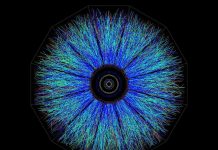
A groundbreaking theory from Dr. Richard Lieu at The University of Alabama in Huntsville (UAH) suggests that gravity can exist without mass, potentially eliminating the need for the hypothetical dark matter.
Dark matter, proposed nearly a century ago by Dutch astronomer Jan Oort, is thought to explain gravitational effects that can’t be accounted for by visible matter.
Despite its importance in explaining phenomena like the clumping of galaxies, direct evidence for dark matter remains elusive.
Dr. Lieu’s new paper, published in the Monthly Notices of the Royal Astronomical Society, presents an alternative explanation.
He proposes that gravity could be generated by certain topological structures, or defects, in the universe’s fabric, rather than by unseen mass.
“My inspiration came from seeking another solution to the gravitational field equations of general relativity,” Lieu explains.
These equations, simplified for galactic conditions, are known as the Poisson equation. Lieu’s work shows that a finite gravitational force can exist even without detectable mass.
This theory is driven by Lieu’s frustration with the dark matter concept, which has remained unproven despite decades of research.
He suggests that the “extra” gravity needed to hold galaxies and clusters together might be due to concentric sets of shell-like structures created during a phase transition in the early universe. A cosmological phase transition is a process where the state of matter changes across the universe.
“It’s unclear what specific phase transition could produce these topological defects,” says Lieu. These defects are dense regions of space, often in the form of cosmic strings or spherical shells. Lieu’s shells consist of an inner layer of positive mass and an outer layer of negative mass.
The total mass of these layers is zero, but a star within these shells would still experience a strong gravitational pull toward the shell’s center.
Gravity involves the warping of space-time, allowing objects to interact gravitationally regardless of their mass. For example, massless photons can still be affected by gravity from astronomical objects.
“Light bending by these shells, which comprise a galaxy or cluster, happens because light is deflected slightly inward as it passes through each shell,” Lieu explains. “The cumulative effect of many shells results in a measurable deflection, mimicking the presence of dark matter.”
According to Lieu, this shell-induced gravitational effect also explains the observed velocities of stars orbiting within galaxies. Both the deflection of light and the motion of stars are used to measure the strength of gravitational fields in large structures.
“My paper contends that these shells are massless,” Lieu asserts. “Therefore, the search for dark matter may not be necessary.”
Future research will focus on how galaxies and clusters form through the alignment of these shells and how these structures evolve. Lieu acknowledges that his paper doesn’t address the problem of structure formation in detail. Questions remain about whether the shells started as planes or strings and how they wind up to form their current shapes.
“Confirming or refuting the existence of these shells will require dedicated observations,” Lieu concludes. “While this theory offers a highly suggestive alternative, it doesn’t disprove the dark matter hypothesis. It does, however, provide the first proof that gravity can exist without mass.”



